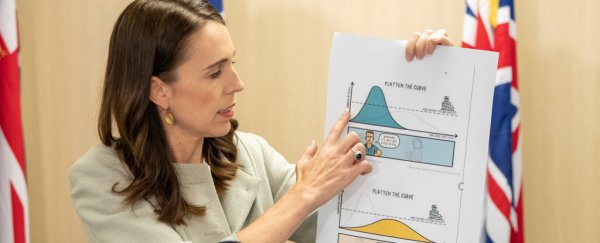The day the US mourned reaching a tragic milestone - 100,000 novel coronavirus deaths - people on the other side of the world in New Zealand celebrated a much more hopeful one: No new coronavirus cases over the prior five days.
What's more, the country's last hospitalized coronavirus patient was discharged, officials said during a press briefing on May 27, according to CBS. Now, only 21 people in the country have active COVID-19 cases.
Overall, the country confirmed about 1,500 cases and 21 deaths, according to Johns Hopkins' Coronavirus Resource Centre.
Meanwhile, the US has confirmed 1.74 million cases (and counting) and, again, more than 100,000 deaths.
Of course, New Zealand is a much smaller country, with a population of 4.8 million to the US's 328.2 million, and more sparsely populated too - 46 people per square mile compared to 94 people per square mile in the US.
That alone hinders the coronavirus's ability to spread.
But overall, like Australia, the country has reported smaller-than-average coronavirus cases and deaths when compared to other Western nations.
"Here in New Zealand, we are all very aware of how lucky we are, and we connect with colleagues overseas and really feel for them," Auckland City Hospital intensive-care specialist Chris Poynter previously told Business Insider.
Experts say it's more than luck, but rather early lockdown efforts, citizen's adherence to the rules, widespread testing and contact tracing, and good communication that are the keys to its success.
New Zealand issued national lockdown efforts early
Beginning February 3, New Zealand began imposing restrictions on travel – even though it had no known cases, Insider's Rosie Perper previously reported.
It recorded its first case February 28 and less than a month later had 102 confirmed cases. At that point, Prime Minister Jacinda Ardern raised the country's alert to Level 3 restrictions, which closed schools, cancelled mass gatherings, and allowed people to speak to their doctors online.
Two days later, the country progressed to Level 4 restrictions, issuing stay-at-home orders country-wide and severely limiting travel.
"At least for New Zealand, it was relatively prompt action at an early stage to go for a strong lockdown," Nick Wilson, a professor and public health expert at the University of Otago in New Zealand, told Perper.
Citizens largely obeyed stay-at-home guidelines
New Zealanders followed those restrictions in earnest, and there's data to prove it.
"The Google data shows that New Zealanders have followed the lockdown rules … with a remarkably high level of behaviour change," Wilson wrote in an April 12 blog post.
"Activity dropped almost instantly, by over 90 percent from baseline levels in some categories," he added.
That led to a levelling off of cases just 10 days after lockdown measures were put in place, he said.
The country instituted widespread testing and contact tracing
According to CBS, New Zealand conducted a total of 267,435 coronavirus tests, and on May 20, it released the NZ Covid Tracer app.
While released later than other countries like Singapore, the app will help to ensure the country doesn't experience a surge in cases as it begins to ease lockdowns. According to the American Enterprise Institute it works by allowing users to scan a QR code at entry points at various venues.
If later, they test positive for the COVID-19, contact tracers can review where the person has been and decide whether to follow up with the venues to alert them of their potential risk.
The Centres for Disease Control and Prevention calls contact tracing "part of a multipronged approach" to tackle the coronavirus pandemic.
Testing and tracing, taken together, "are the backbone of public-health work," Insider's Hilary Brueck reported.
The Prime Minister communicated well and is trusted by the public
According to Wilson, "New Zealand shows the benefit of having quite high levels of scientific expert input into the policymaking process and a Prime Minister who is a very good communicator who the public trust."
Arden was also praised for taking a 20 percent pay cut, along with other top government officials.
In the US, by contrast, the messaging has been inconsistent, with President Trump first saying the outbreak "may get a little bigger; it may not get bigger at all," while health officials said it was inevitable that the coronavirus would spread inside the US.
Social media has also "spread erroneous rumours" about fatality rates, Rosemary Taylor, an associate professor of sociology and community health at Tufts University, previously told Insider.
News media has delivered conflicting messages.
But in order for people to take threats seriously, she said, they need "government transparency, a robust belief in scientific data, and a faith in international cooperation – to all of which President Trump has expressed antagonism in the past."
This article was originally published by Business Insider.
More from Business Insider:
